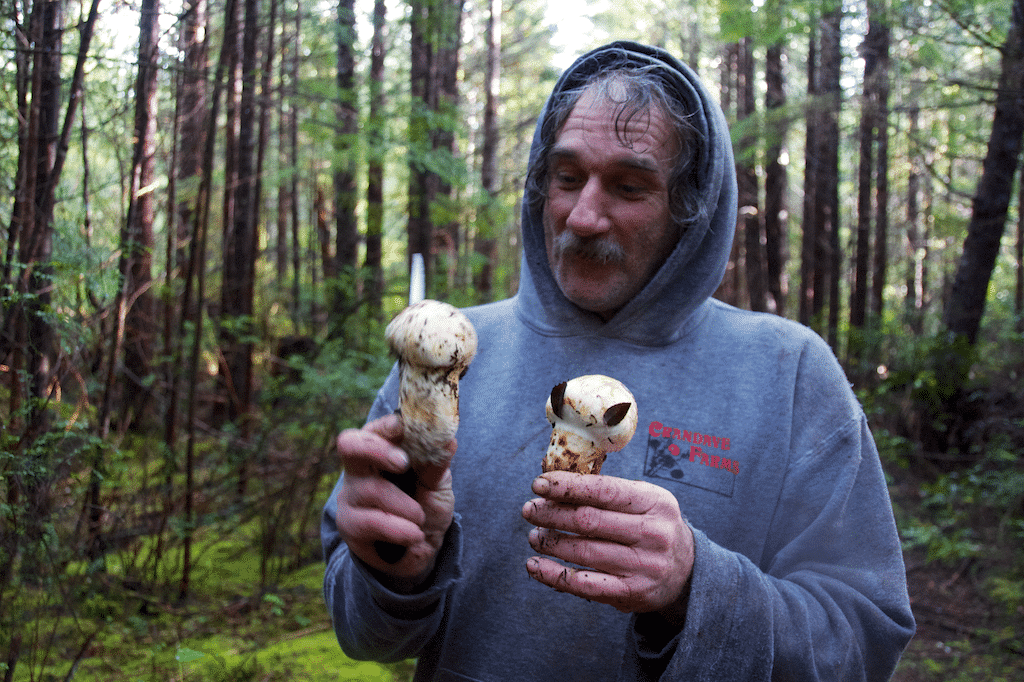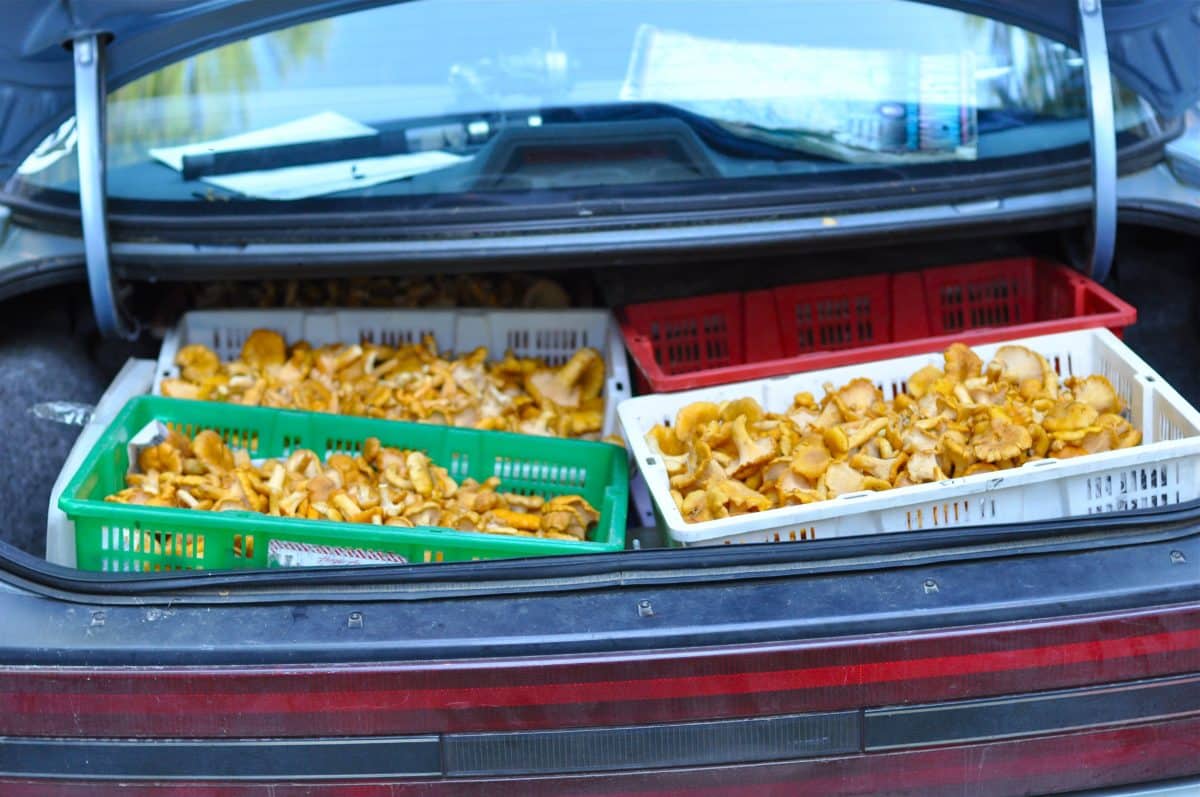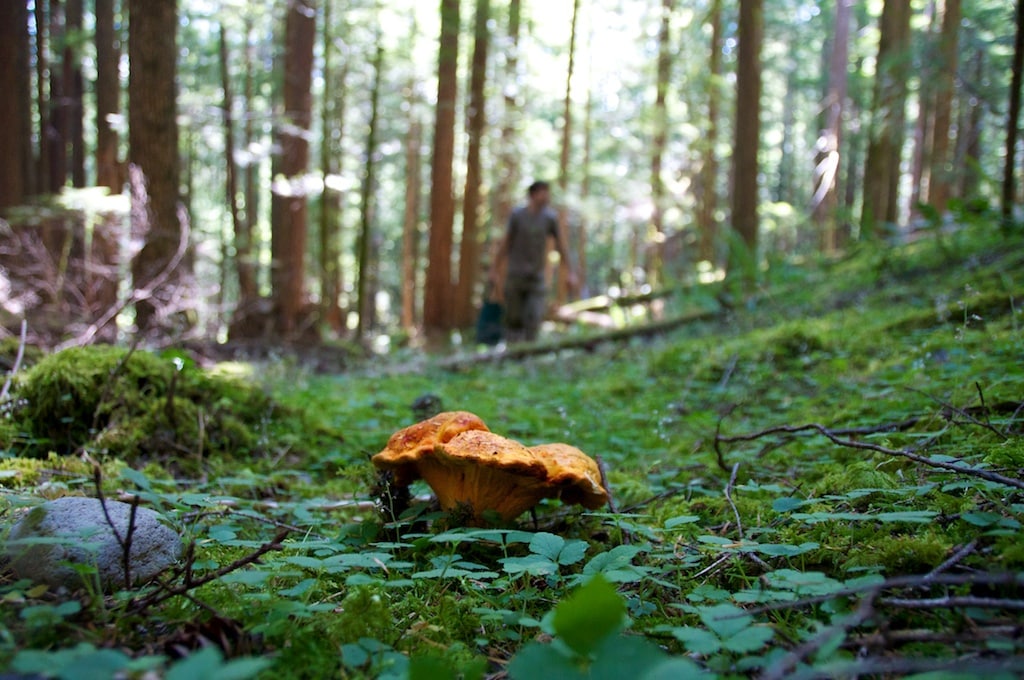My autumn begins in the last days of August. That’s when I’m doing a rain dance, much to the displeasure of hikers, bikers, and mountain climbers who dream of eking out just a few more weeks of sun to carry them through late summer expeditions.
Me: I’m calling down thunderheads.
Last fall the weather gods came through. We got a good drenching in the second half of August and the mushrooms responded in kind. Porcini with caps the size of cantaloupes popped up under the huckleberry bushes. Day-Glo orange lobster mushrooms decorated the mossy floor of ancient Douglas-fir forests. You could hardly walk through damp woods without stepping on a golden chanterelle, and even the normally scarce blue chanterelle was afoot along mountain passes.

So, in a season of plenty, it was with some surprise that I learned of my friend Doug’s retirement. Doug has picked wild mushrooms for profit for more than thirty years. His position in this colorful backwoods economy dates nearly to the earliest beginnings of the industry. Commercial foragers began supplying restaurants and farmer’s markets with wild mushrooms in earnest in the 1970s, right around the time Americans started asking themselves some basic questions about where our food comes from. The trade picked up in subsequent decades with the simultaneous downturn in timber harvest (and its resultant unemployment line of woods-savvy loggers) and an uptick in interest in all things local, organic, and artisanal. Since then the business has blossomed across the continent and in the Pacific Northwest in particular. In many ways, the wild mushroom is a poster child for the new food movement: de facto organic, tended by nature beyond the fencelines of Big Ag, and host to complex, beguiling taste profiles.
When Doug told me he was getting too old to pick professionally, I was skeptical. He was only in his mid-fifties and still able to get around like a mountain goat. Back in the day, Doug logged coastal old-growth cedar. He fished for crab and dug razor clams. As a mushroom picker, he combed Washington rainforests for chanterelles in the 1980s, joined the brief matsutake boom in Oregon’s Cascade Mountains in the 1990s, and followed the apocalyptic path of inner-mountain wildfire throughout the 2000s in search of burn morels. In many ways, he was the face of professional mushroom picking, a largely hidden economy of pickers and buyers that’s now the largest (legitimate) all-cash business in the country.

More likely an explanation for his farewell was the growing-up of the industry—and with it, a loss of free-wheeling mystique. The Internet has flattened the learning curve, ushering in a whole new generation of greenhorn pickers. Secret spots aren’t so secret anymore. And then there’s the bureaucracy: regulators have latched on to the trade in wild mushrooms like pitbull terriers. “Ain’t worth a cheap bucket of mushrooms,” Doug told me.
I was sad to hear this news.

For the last few years I had followed Doug around the mountains and coastal forests of the greater Pacific Northwest, trying to get a glimpse of a seldom-seen subculture. The pickers and buyers form an iconoclastic and carnivalesque confederacy in an age of increasingly button-down, business-as-usual moneygrubbing. Certainly they weren’t in it for the payout, which can be non-existent in a poor season; on the other hand, “running around the woods for a living,” as Doug puts it, is enough for many, your only boss the weather. Our vagabonding on what’s known as the mushroom trail, with its echoes of the Gold Rush, was a look back at a sort of frontier-style capitalism that’s nearly gone today.
Doug used to sell many of his mushrooms to a buyer named Jeremy Faber, who runs a company in Seattle called Foraged and Found Edibles. For Faber, a tireless seeker of all foods wild, the growth is welcome. He’s got toeholds in New York City and Boston now, and ships his all-natural products halfway around the world. Ironically, he makes more money during times of scarcity. The mushroom glut of last fall meant a crash in prices and way too many sub-par products flooding the market.



As a buyer who deals in what’s called “fresh market,” Faber’s allegiance is to high-end restaurants and quality farmer’s markets. His porcini ends up in Beef Bourguignon, his hedgehogs in a Winter Root Vegetable Gratin, his black trumpets dotting risottos and diver scallops. Above all, he wants a chef — and by extension, a diner — to experience mushroom nirvana with his loamy wares.
Thankfully, my own interest in wild fungi will always have the dull patina of what Faber likes to call amateurism. Despite my many hours spent on the mushroom trail, I’m still an aspirant, a recreational fungi finder. And even though I’m once again praying for rain in August, it’s still just a walk in the woods I’m after, without the complicating matters of commerce — a chance to put boots to the ground, get fresh air among high-rent scenery, relish the thrill of the hunt, and maybe, if the cards break the right way, strike a small jackpot of extraordinary ingredients. ![]()

First published August 2014

